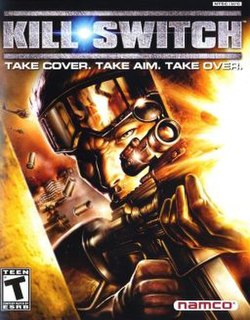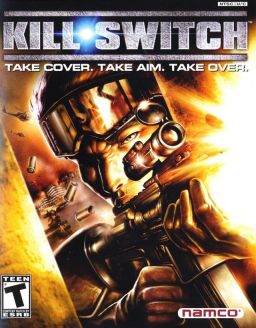Kill Switch (video game)
2003 third-person shooter game by Namco USA From Wikipedia, the free encyclopedia
Kill Switch (stylized as kill.switch) is a third-person shooter video game developed and published by Namco Hometek for the PlayStation 2 and Xbox. A port for Microsoft Windows was released in 2004 while an abridged Game Boy Advance port developed by Visual Impact was released the same year.[7] The PAL release of the PS2 port came with a demo of SOCOM II U.S. Navy SEALs on a separate disc, as Sony Computer Entertainment released the game in Europe.
| Kill Switch | |
|---|---|
 | |
| Developer(s) | Namco Hometek[1] Visual Impact (GBA) |
| Publisher(s) |
|
| Designer(s) | Chris Esaki[3] |
| Programmer(s) | Gil Colgate |
| Writer(s) | Alvin Muolic |
| Composer(s) | Kevin Manthei |
| Engine | RenderWare |
| Platform(s) | PlayStation 2 Xbox Microsoft Windows Game Boy Advance |
| Release | |
| Genre(s) | Third-person shooter |
| Mode(s) | Single player |
The most distinguishing characteristic of Kill Switch is its cover system, a mechanic that has the player character taking cover behind objects and around corners in a manner similar to Namco's own Time Crisis series of light gun shooters as well as Koei's third-person shooter WinBack[8] and Hideo Kojima's stealth game Metal Gear Solid 2: Sons of Liberty.[9]
Story
Protagonist Nick Bishop (voiced by Marcus McCollum) is a super-soldier remotely controlled via direct neural connection by a man known only as "Controller" (voiced by Chuck McQuary) in a series of combat missions designed to bring "the North" and "the West" to war. Profiteer Archer (voiced by Adam Baldwin) plans to benefit by selling the technology used to control Bishop, who gives Controller headaches on recollection of suppressed memories featuring a woman and the phrase "Say my name". Moments before launching a biological warhead, Controller is killed by a surge triggered when a woman known as "Duchess" (voiced by Adrienne Wilkinson) seizes control of Bishop. Sent to attack Controller's base, Bishop's memories are eventually restored: the woman from his memories was his new wife, who Archer killed when he captured Bishop to sell the technology inside him. Freed, Bishop kills Archer in a final assault and walks away.
Reception
Summarize
Perspective
| Publication | Score | |||
|---|---|---|---|---|
| GBA | PC | PS2 | Xbox | |
| Edge | N/A | N/A | 6/10[4] | N/A |
| Electronic Gaming Monthly | N/A | N/A | 6.67/10[14][a] | 6.67/10[14] |
| Eurogamer | N/A | N/A | 7/10[15] | N/A |
| Game Informer | N/A | N/A | 7/10[16] | 7.5/10[17] |
| GameSpot | N/A | 6/10[18] | 6.9/10[19] | 6.9/10[19] |
| GameSpy | N/A | |||
| GameZone | N/A | N/A | 8/10[23] | 8.5/10[24] |
| IGN | 7.5/10[7] | 7.8/10[25] | 8/10[26] | 8/10[26] |
| Nintendo Power | 3.3/5[27] | N/A | N/A | N/A |
| Official U.S. PlayStation Magazine | N/A | N/A | N/A | |
| Official Xbox Magazine (US) | N/A | N/A | N/A | 7.8/10[29] |
| PC Gamer (US) | N/A | 70%[30] | N/A | N/A |
| X-Play | N/A | N/A | N/A | |
| Playboy | N/A | N/A | 75%[32] | 75%[32] |
Reception
Kill Switch received "average" reviews on all platforms except the Xbox version, which received "generally favorable reviews", according to the review aggregation website Metacritic.[10][11][12][13] Criticism was directed towards its thin plot and simplistic level design, while the gameplay mechanics, especially the cover system, were lauded and considered engaging. It was compared to the Time Crisis series. The Xbox version was said to possess enhanced graphics over the PS2 version. GamePro said of the former console version, "Barring some stiff animation and occasional collision-detection fumbles, kill.switch's textures and character models are the stuff. The controls take a while to master, but once you do, they are super slick. Some of the voice acting is pretty haggard, but overall the sound is muscular. A mega effort."[33][b]
Legacy
Summarize
Perspective

Kill Switch is best remembered for its cover system as a core game mechanic,[citation needed] and for introducing the blind fire mechanic to the cover system.[34] Several shooters took inspiration from Kill Switch and implemented similar cover systems. In the design of Gears of War, lead developer Cliff Bleszinski of Epic Games credits Kill Switch's cover system as one of the influences they put into the game's design,[35] as its lead designer Chris Esaki was employed by Epic Games and was involved in the development of Gears of War.[3]
Naughty Dog's Uncharted: Drake's Fortune, which began development in 2005 and was released in 2007,[36] also took inspiration from Kill Switch, which Uncharted's lead designers Evan Wells and Amy Hennig credited as inspiration for the game's cover system.[37] Other examples of shooters that featured Kill Switch-inspired cover systems include the 2005 third-person shooter CT Special Forces: Fire for Effect,[38] and the 2006 games Tom Clancy's Rainbow Six: Vegas,[39] a first-person shooter released in the same month as Gears of War,[40] and Killzone: Liberation, a third-person shooter released a month before Gears of War.[8]
Notes
- Three critics of Electronic Gaming Monthly gave the PlayStation 2 and Xbox versions each a score of 6/10, 6.5/10, and 7.5/10.
- GamePro gave the Xbox version two 4/5 scores for graphics and fun factor, 3.5/5 for sound, and 4.5/5 for control.
References
External links
Wikiwand - on
Seamless Wikipedia browsing. On steroids.
